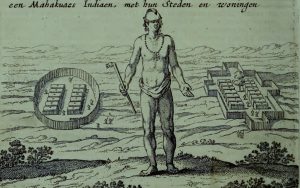
Historical background
Fort Nassau was the first trading post in New Netherland in what is now Albany. Set up in 1614 by an association of merchants called the New Netherland Company, the place was abandoned due to frequent flooding. Fort Orange was built as a replacement in 1624 and became as much a Dutch asset as it was a Mohawk asset. The trade was beneficial for both parties. Upriver there was more respect for Iroquois power.
Many early contacts between Dutch and Native Americans have been recorded. While early modern Dutch voices are dominant, sometimes the voices of Native Americans can be found. For example, in 1659 a Mohawk chief (unfortunately the name is unknown) was noted as saying: “The Dutch say we are brothers and that we are joined together with chains, but that lasts only as long as we have beavers. After that we are no longer thought of.”
Traces
In Albany, traces of the Dutch, Native American and African American heritage can be found at mansions, churches and burial sites. Albany also had an important headquarters for abolitionists, included in our map, housing a committee that helped approximately 300 fugitives as part of the Underground Railroad.
Curious about slavery heritage in other regions within the USA? Take a look at our overview of maps.


